Polished 2020 G70 gives Hyundai a step-up sedan
By John Gilbert
U.S. car buyers have completely converted their attention from traditional sedans to SUVs, trucks and crossovers at such a pace that it’s futile for companies to keep making those old-fashioned conveyances. We all know that.
Or do we? Hyundai begs to differ, despite the overwhelming shift in sales figures and profit, the South Korean giant has presented us with vehicles like the 2020 G70, under the newly separated Genesis luxury line. What are they thinking?
Sales numbers show that even the most stalwart cars, like the Camry, Accord, and Civic, have been displaced by SUVs like the RAV4 and the CR-V, which are now the leading sellers for Toyota and Honda, respectively. Same with Nissan, where the compact Rogue SUV is the top selloer. So convinced are car-makers that giants such as Ford and General Motors have halted production of a lot of cars that used to carry their colors into annual sales competition.
And then there’s Hyundai, which has zoomed up to the top echelon in technology, safety and popularity to become a giant in automotives, over the last 10 years. And while Hyundai seems to be in a hurry to get to the top, it is not so much in a hurry to give up on cars. Sedans, even. Hyundai, in partnership with KIA, continues to reach higher into the hallowed ground of SUVs, but they also continue to make very impressive sedans. And they’re reaching for more.
For 2019, Hyundai introduced the Genesis G70, a 4-door sedan version of its flashy coupe, and at the most reasonable end of the three cars — G70, G80, and G90 — with which it has endowed its new and separate high-end Genesis brand. As a brand new model, the G70 surprised many in the industry by being named Car of the Year. KIA had come out with the highly successful Stinger a year earlier, so the platform was there, and Hyundai shortened it to more compact dimensions, and filled it up with elements that are aimed at luxury and sportiness, and achieved that hard-to-achieve combination.
Up on Lake Superior’s North Shore, outside of Duluth, Minnesota, we got an early start on our winter-that-never-ends season where drivers had to contend with heavy snow and cold long before 2019 ended, so I was pleased to get a week-long test drive in a Genesis G70, and it was the loaded G70 AWD 3.3T Sport, which gets your attention immediately, with a sticker price of $53,245.
That strikes you as a lot for a company that started out, and climbed, by building economy cars, then economical cars, adding style, then luxury, then sport, but keeping the sticker price far less than you’d assume, for all you’re getting. Turns out, the new G70 does exactly that, punching above its weight class by far, considering it starts with a base price of $46,650, and is a very impressive entry-luxury car at that price.
Once you drive the car — particularly after a blizzard hits — you appreciate all it offers and how much attention has been paid to make you comfortable and secure, while also holding the hammer of high performance. A turbocharged V6 with 365 horsepower and 376 foot-pounds of torque, delivered through a superb all-wheel-drive system, offers plenty of performance in a sleek, BMW-esque shape.
The usual high-end Hyundai technology is everywhere, including the outstanding lane-departure and lane-centering devices, all the connectivity you could want, simple execution of top-end luxury, and style — along with the high-grade steel placed strategically throughout the platform.
Real-world luxury starts with the Nappa leather bucket seats that are heated front and rear and offer support and comfortable firmness. And it goes right on through the head-up display of redundant information in the driver’s line of vision and to the brilliantly lighted outside, with LED headlights, taillights and daytime running lights. The headlights have auto-dimming, naturally, because the test car came equipped with all the standard equipment as well as the Elite package, with adaptive lighting, parking sensors and parking assist, plus the Prestige package, and the Sport package. with the surround video screen monitor, quilted Nappa leather seats and head-up display, and the Sport package, with 19-inch black alloy wheels, electronic suspension, and the dark chrome grille.
The wheels are larger than standard, and measure 225-40 19 front and 255/35 19 rear — just so you won’t be tempted to do the easy seasonal front-to-rear swap. Is that necessary? Not sure, but I often accuse designers and engineers of successfully avoiding the need to buy after-market tires or they wouldn’t add such complexities to car ownership.
The powertrain is a gem, with the 3.3-liter V6, twin turbocharged to send 365 horsepower and a whopping 376 foot-pounds of torque to all four wheels. An 8-speed automatic governs the power to all four wheels, which is something you appreciate mostly in Winter driving when “winter” is spelled with a capital W. The transmission shifts smoothly all the way from 1 through 8, and can be manually overridden by paddles on the steering wheel to execute the rev-matching shifts.
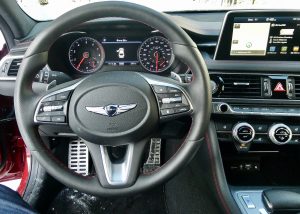
Assorted switches on steering wheel, including shift paddles, are efficient and ergonomically sound.
All that power makes the G70 a kick to drive, although it never feels like a hot rod, maybe because of all the luxurious accoutrements and computer gadgetry. But get on it hard and you find it has plenty of punch that complements its insistence on staying firmly planted in cornering, and smooth at freeway speed.
The twin turbos make it easy to get on it hard, and difficult to get on it easy, so the EPA estimates of 17 city and 25 highway usually flank what you’re actually attaining. I didn’t get the G70 out on the freeway for any kind of trip, so I can’t say that we ever cruised at 25 miles per gallon or more, but it was easy to get 23 or 24 in city driving, which makes me believe you could get close to 30 with sustained cruising and mellow throttle usage.
The G70 is not the luxury liner the G90 is, but it does have all the luxury anyone could seek, and it’s a sporty luxury combined with crisp handling and that potent power, which gives it a sporty edge that most luxury cars don’t strive for. Plus, all the electronic gadgetry works well and efficiently, satisfying the desires of the technocrats. All those things working in harmony puts the G70 on a plane that would require comparison shoppers to check the BMW lineup, or Audi or Mercedes, but German, for sure.
Hyundai didn’t earn the right to have its new G70 mentioned in the same sentence with BMW, but it has earned that status by remaining committed to building cars, from the subcompact Accent to the compact Elantra and extremely slick midsize Sonata, and on up to the Genesis models. The company is not being overly bold, but it has maintained the belief that sedans are not going away.
While buying into the profit margins of SUVs, at Hyundai they believe that it may be cyclical, and while many SUV buyers are happy with their purchases, they may prefer to revisit the sedan market once they revisit the varieties for their second vehicle, where the right sedan might beat having two SUVs.
If that happens, and plenty of market research indicates it well could, a good number of those buyers might want a sedan that is a cut above others in features, luxury or sportiness. And with the G70, Hyundai already has a proven winner at a price tag that is not all that expensive, after all.


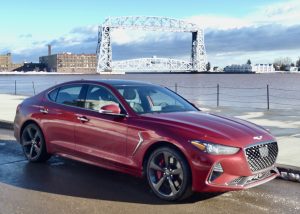
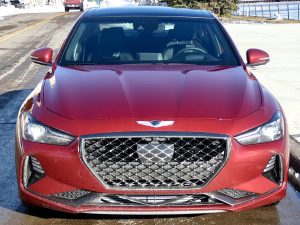
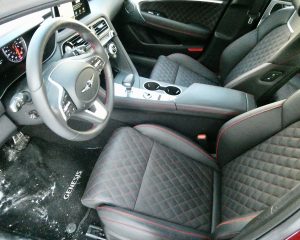
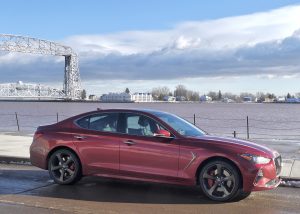
 John Gilbert is a lifetime Minnesotan and career journalist, specializing in cars and sports during and since spending 30 years at the Minneapolis Tribune, now the Star Tribune. More recently, he has continued translating the high-tech world of autos and sharing his passionate insights as a freelance writer/photographer/broadcaster. A member of the prestigious North American Car and Truck of the Year jury since 1993. John can be heard Monday-Friday from 9-11am on 610 KDAL(www.kdal610.com) on the "John Gilbert Show," and writes a column in the Duluth Reader.
John Gilbert is a lifetime Minnesotan and career journalist, specializing in cars and sports during and since spending 30 years at the Minneapolis Tribune, now the Star Tribune. More recently, he has continued translating the high-tech world of autos and sharing his passionate insights as a freelance writer/photographer/broadcaster. A member of the prestigious North American Car and Truck of the Year jury since 1993. John can be heard Monday-Friday from 9-11am on 610 KDAL(www.kdal610.com) on the "John Gilbert Show," and writes a column in the Duluth Reader.